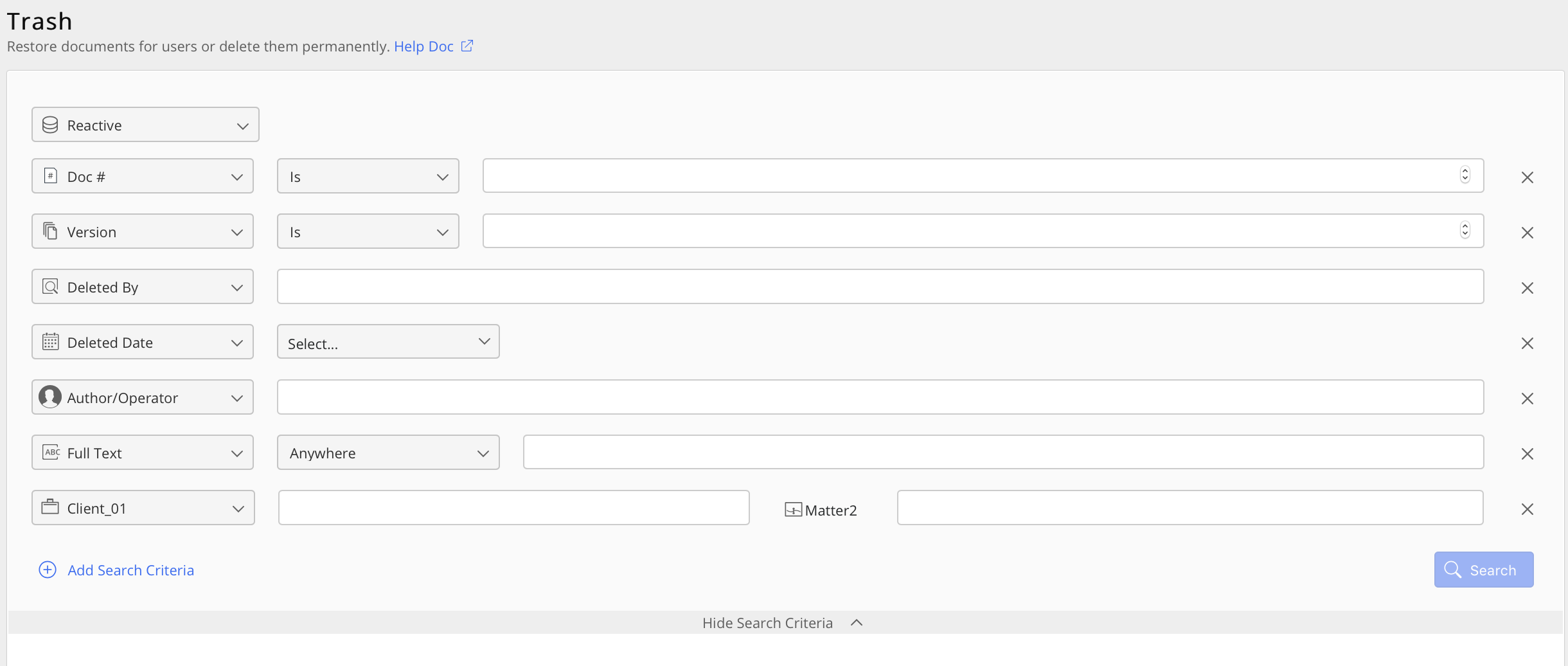Trash
The Trash page enables you to manage deleted documents. You can restore the documents for users or delete them permanently. When documents are deleted, they are no longer visible in search results or when browsing through folders. However, they are available in the User Trash, a feature in client applications, as well as in iManage Control Center under Trash. When a document is restored, its location, metadata, and security are restored along with the document.
Use the Trash page to:
Restore documents that were deleted by users from client applications.
Permanently delete documents.
View the details of deleted documents using the View option.
Searching for deleted documents
Select Content > Trash. The list of default search fields appears as shown in the following figure:
Figure: Trash page
Use these search fields to refine your search, then select Search.
iManage Control Center preserves the search fields you enter when searching for documents, workspaces, or trash. When you add or remove search fields, your settings are automatically saved and will be present the next time you sign in and access the Documents, Workspaces, or Trash pages. This provides the advantage of not having to remember or reselect your search fields for subsequent searches.
Search fields are stored locally in the browser's cache for each individual library. If you switch to a different browser or to a different device, you will see the default search fields.
Restoring documents
Single document
This option is available on the:
Ribbon bar: Select documents to see this option on the ribbon bar.
Kebab menu: S elect an
 icon adjacent to each document
to see this option.
icon adjacent to each document
to see this option.
Context menu: Right-click a document to see this option.
The following steps are explained using one of the preceding options:
Enter filter parameters in the search fields to retrieve deleted document.
If no records found,
Select Reset Search Criteria in the lower-right corner of the Search Criteria section.
If records are found,
Hover the mouse pointer over the desired document, right-click, and select Restore . The Restore dialog box appears.
Enter the following details:
In the On Behalf Of field, enter the user ID for whom you want to restore document for.
Optionally enter the Audit Comment.
Select Restore. The deleted document is restored, along with its metadata and security, to the parent folder from where it was deleted.
When the restoration is successful, select Copy Link on the progress bar to copy the link to the document in iManage Work; one link is created for each document.
Send the copied link to the user, whose document you have restored . The user can paste these links in a browser and open the document in iManage Work.
Multiple documents
This option is available on the ribbon bar when you select documents.
Enter filter parameters in the search fields to retrieve deleted documents.
If no records found,
Select Reset Search Criteria in the lower-right corner of the Search Criteria section.
If records are found,
Hover the mouse pointer over the desired document, right-click, and select Restore . The Restore dialog box appears.
Enter the following details:
In the On Behalf Of field, enter the user ID for whom you want to restore documents for.
Enter the Audit Comment and select Restore. The deleted documents is restored, along with its metadata and security, to the parent folder from where they are deleted.
When the restoration is successful, select Copy Link on the progress bar to copy the link to the documents in iManage Work; one link is created for each document.
Send the copied link to the user, whose documents you have restored . The user can paste these links in a browser and open the documents in iManage Work.
Permanently Deleting documents
This feature enables you to permanently delete documents.
Single document
This option is available on the:
Ribbon bar: Select documents to see this option on the ribbon bar.
Kebab menu: Select an
 icon adjacent to each document to see this option.
icon adjacent to each document to see this option.
Context menu: Right-click a document to see this option.
The following steps are explained using one of the preceding options:
Enter filter parameters in search fields to retrieve deleted documents.
If no records are found, refine your search criteria and select Search to perform another search.Select Clear Values in the lower-right corner of the Search Criteria section.
If records are found, right-click the document and select Permanently Delete .
The Permanently Delete dialog box appears .
Confirm the action. If you select Delete , you receive an acknowledgement for the delete action. If you select Cancel , the delete action gets cancelled.
Multiple documents
This option is available on the ribbon bar when you select documents.
After performing a search on the Trash page, place a check mark beside each document that you want to permanently delete.
On the ribbon bar, select Permanently Delete . The Permanently Delete dialog box appears . Confirm the action. If you select Delete , you receive an acknowledgement for the delete action. If you select Cancel , the delete action gets cancelled.
Viewing document details
Use the following steps to view information about a document before permanently deleting or restoring it .
Kebab menu: Select an
 icon adjacent to each document to see this option.
icon adjacent to each document to see this option.
Context menu: Right-click a document to see this option.
Clickable link: I n the DOC#/Version column, select a document.
Use one of the above option and select View.
 .
. option is displayed; select it to reset the search criteria.
option is displayed; select it to reset the search criteria.